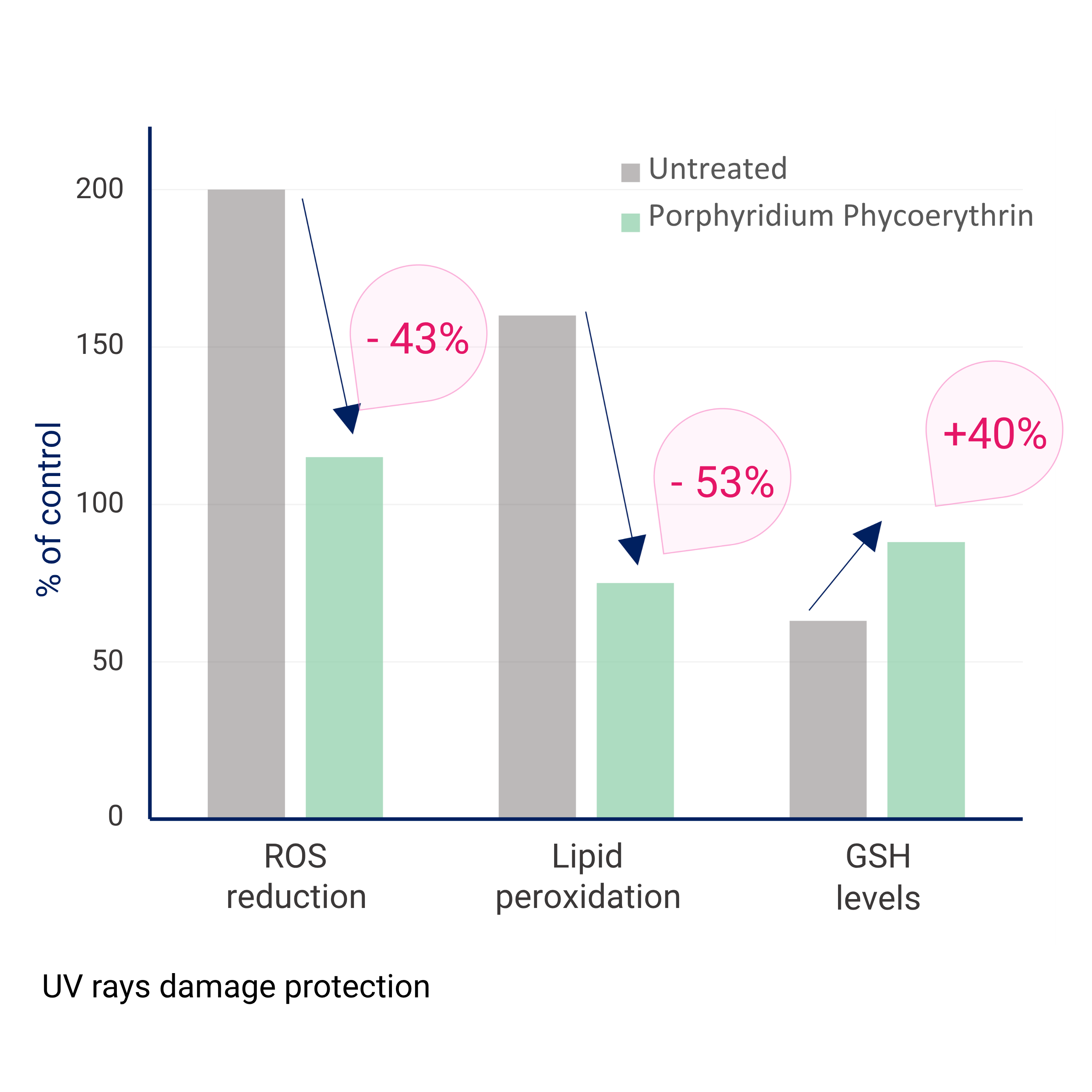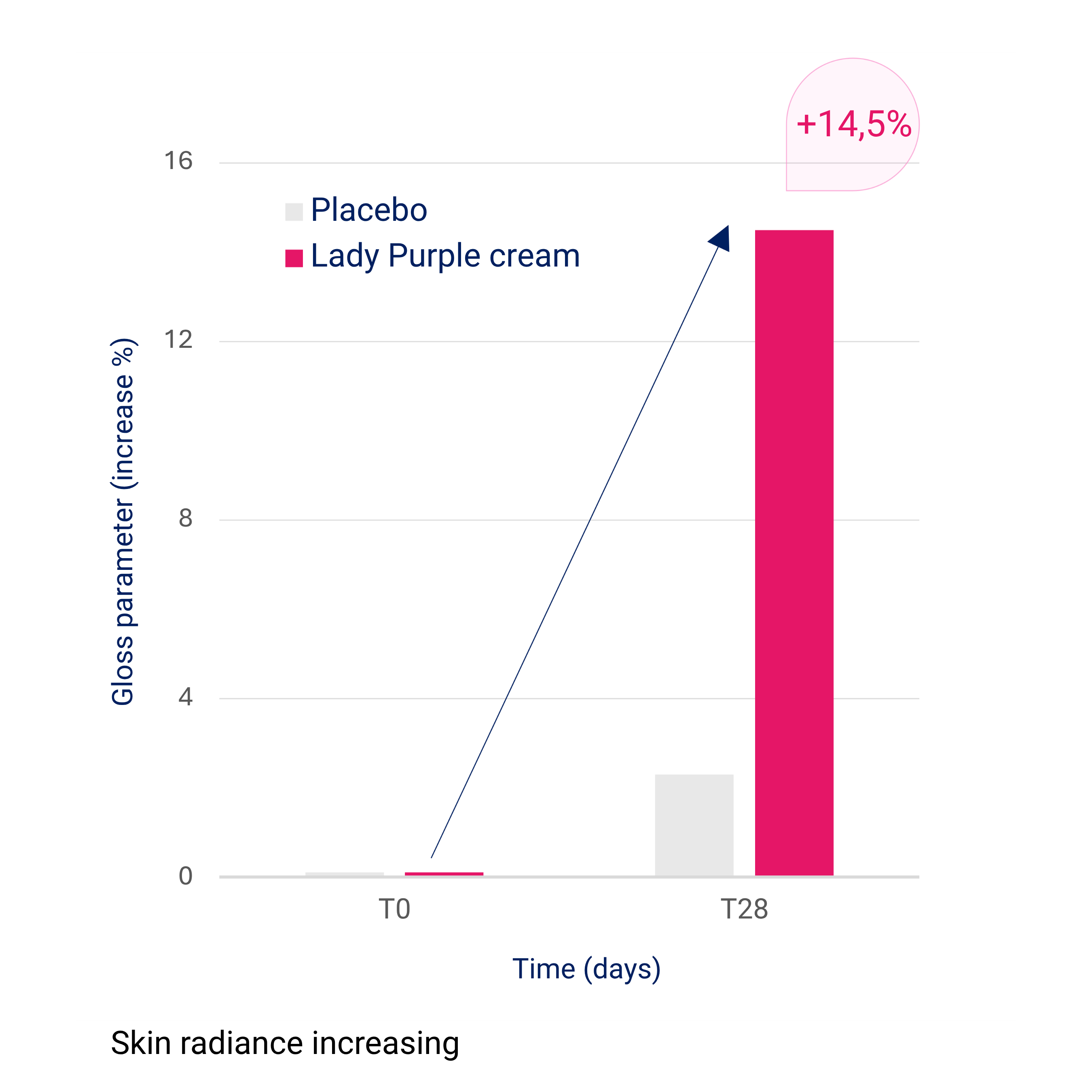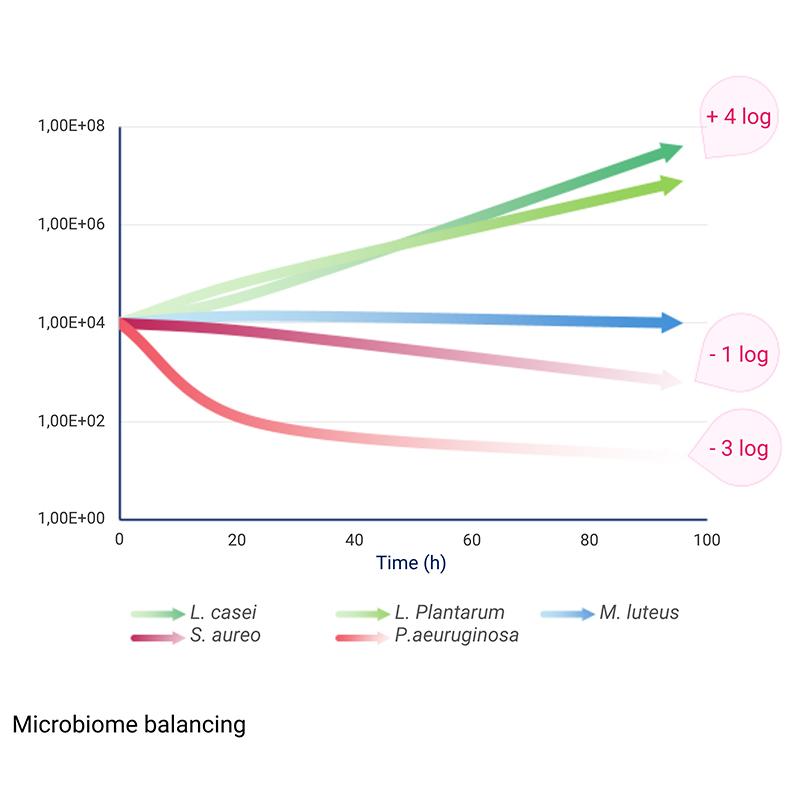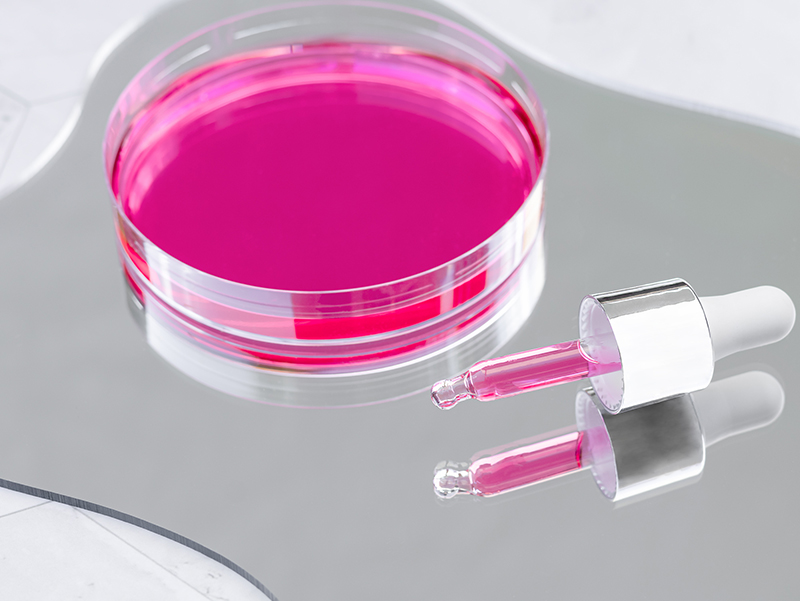The evolution of beauty formulations is undergoing a pivotal transformation that is driven not only by performance but also by provenance. As sustainability becomes a baseline rather than a differentiator, formulators are increasingly turning to upcycled ingredients to reduce waste and align with circular economy principles.
One standout in this emerging space is Lady Purple®, a bioactive ingredient extracted from Porphyridium cruentum, a red microalga known for its potent antioxidant and hydrating molecules.
Lady Purple® offers an elegant solution that unites efficacy and sustainability. Through enzymatic upcycling, it transforms by-product biomass from microalgae farming into a high-value, multifunctional cosmetic ingredient. Lady Purple® is more than just another cosmetic active ingredient, but rather a model of circular, bio-based innovation for the next generation of skincare.
From waste to worth: the power of enzymatic upcycling
The heart of Lady Purple®'s sustainable identity lies in its upcycling process. Lady Purple is extracted from the biomass of Porphyridium cruentum, residual from the production process of certain metabolites. This means that a waste product is transformed into a value-added ingredient with important cosmetic properties. The microalgae cultivation system actively sequesters CO2 from the atmosphere, reduces emissions, and requires minimal land use, making the entire process highly virtuous and planet-friendly.
The enzymatic extraction, employed further in its production process, avoids solvents, reduces energy consumption, and operates at low temperatures, preserving delicate bioactive compounds. Enzymes selectively degrade the microalgal cell wall, releasing high-value molecules like phycoerythrins and sulfated polysaccharides, which are then isolated using microfiltration. This yields a water-soluble, preservative-free bioactive with vibrant pink coloration and multifunctional efficacy—traits rarely seen in a single ingredient.
This form of green biotechnology not only ensures zero-waste production but also enhances ingredient potency and safety. Compared to solvent-based extraction, enzymatic hydrolysis has been shown to retain a broader range of bioactive structures with minimised environmental impact.1
Phycoerythrins and polysaccharides released during the process of enzymatic extraction are the driving the power behind the efficacy of Lady Purple®.

Phycoerythrins: natural antioxidants and optical enhancers
A standout feature of Lady Purple® is its high concentration of β-phycoerythrin, a water-soluble chromoprotein responsible for the microalga’s signature pink hue. These phycobiliproteins, long studied in marine biology, function as light-harvesting complexes during photosynthesis and
possess strong antioxidant capabilities, neutralising reactive oxygen species (ROS) and stabilising cell membranes.2
When applied topically3, Phorphyridium phycoerythrin has been shown to mitigate UV-induced oxidative stress in human keratinocytes by reducing ROS levels up to -43% and preventing lipid peroxidation by -53%, according to in vitro studies.

The compound also offers optical benefits. Its natural fluorescence enhances light reflection, giving skin a more luminous appearance. In vivo testing4 results, using a cream with 5% Lady Purple®, showed a +14.5% increase in skin radiance after just 28 days of use.
These properties make it ideal for formulations targeting UV-induced damage and supporting skin rejuvenation.
Polysaccharides: hydration and barrier fortification
Complementing phycoerythrins, Porphyridium cruentum secretes sulfated exopolysaccharides that act as a natural protective barrier. These complex sugar polymers form a biofilm around the microalga, aiding in moisture retention and cellular defence. In dermatological applications, they deliver colloidal, moisturising, and elasticising properties, contributing to long-lasting skin hydration and barrier support.
These effects are corroborated by in vivo testing. A serum containing 5% Lady Purple® improved skin hydration by +33% and increased elasticity by +7.4% within 10 hours, as measured by corneometry and cutometry respectively.5 These immediate results suggest rapid skin-plumping and barrier-enhancing effects, valuable for both rejuvenating and sensitive skin applications.
Such findings align with research on marine polysaccharides, which have been shown to stimulate skin fibroblast proliferation and improve water retention.6

Restoring skin microbiome balance
Beyond surface benefits, Lady Purple® also acts on the skin microbiome, promoting equilibrium between beneficial and pathogenic species. In vitro studies7 demonstrate that it stimulates the growth of probiotics like Lactobacillus casei and L. plantarum while inhibiting opportunistic pathogens such as S. aureus and P. aeruginosa.
This dual-action makes it particularly relevant for formulations aimed at sensitive, acne-prone, or compromised skin barriers. The concepts of “prebiotic skincare” and “microbiome skincare” are gaining traction, and Lady Purple® aligns with this trend by supporting a balanced cutaneous ecosystem without the use of preservatives or synthetic antimicrobials.
These effects reflect broader microbiome research indicating that modulating the skin’s microbial community can improve symptoms of dermatitis, reduce inflammation, and strengthen the barrier.8
Clinically validated, consumer-aligned efficacy
Lady Purple® is one of the few upcycled ingredients that combines robust sustainability claims with clinically proven cosmetic performance. In a placebo-controlled, half-face study of 22 female subjects aged 40–65 with photoaged, dull skin, Lady Purple® cream led to:
- 13.6% reduction in wrinkle depth (crow’s feet area)
- -2.8 years “younger skin” effect, as assessed by reference age-wrinkle mapping
- >90% satisfaction across all questionnaire parameters after 28 days
These outcomes confirm that upcycled cosmetic bioactives can deliver measurable results, not just sustainability headlines. As beauty consumers tend to prioritise performance and molecular level benefits, while expecting the cosmetic brands to be environmentally responsible, combining visible efficacy with eco-conscious sourcing is no longer optional—it is the new standard.

Scientific context and market trends
The efficacy and multifunctionality of Lady Purple® are further reinforced by a growing body of literature on microalgae-derived ingredients. Porphyridium cruentum extracts have been studied for their anti-inflammatory, photoprotective, and immunomodulatory properties9, while microalgal polysaccharides are being explored as biocompatible humectants in topical therapies.10
At the same time, the trend toward upcycled actives is being driven by consumer scrutiny, industry regulation and innovation incentives. According to a 2023 report by Ecovia Intelligence, upcycled ingredients are expected to grow by over 15% annually, especially in categories like anti-pollution, hydration and blue light protection.
Lady Purple®, with its data-backed efficacy and full circular lifecycle, perfectly aligns with this direction. It supports brands in making meaningful, science-driven sustainability claims while delivering tangible results that resonate with consumers.
Its bright pink hue also lends itself to formulation storytelling, visually reinforcing the concept of efficacy and natural origin in the final product. For brands, this is a key visual differentiator that supports shelf appeal and marketing narratives.
Conclusion
Lady Purple® is more than just a novel active—it is a manifestation of the future of ingredient sourcing. By leveraging the power of biotechnology, enzymatic precision and circular economy thinking, it redefines what it means to be a clean, effective and sustainable cosmetic ingredient.
As the cosmetic industry shifts to evidence-based green innovation, upcycled ingredients like Lady Purple® pave the way. They prove that beauty can be regenerative, performance-driven, and responsibly made.
1 Dumay et al., 2013, Bioresource Technology
2 Bermejo et al., 2008, Marine Drugs
3 Active Cells Biotechnology s.r.l. Unpublished report, 2025
4 Active Cells Biotechnology s.r.l. Unpublished report, 2025
5 Active Cells Biotechnology s.r.l. Unpublished report, 2025
6 Kim et al., 2021, International Journal of Biological Macromolecules
7 Active Cells Biotechnology s.r.l. Unpublished report, 2025
8 Sanford & Gallo, 2013, Seminars in Immunology
9 Raposo et al., 2013, Marine Drugs
10 Li et al., 2022, Carbohydrate Polymers
References:
1. Dumay, J., Radier, A., Barnathan, G., & Jaouen, P. (2013). Recovery of water-soluble proteins from Ulva lactuca using enzymatic hydrolysis: Optimization and process integration for protein production. Bioresource Technology, 128, 586–593. https://doi.org/10.1016/j.biortech.2012.10.115
2. Bermejo, R., Talero, E., García-Mauriño, S., Avila-Roman, J., Rodríguez-Luna, A., Alcaide, A., ... & Motilva, V. (2008). Porphyridium cruentum as a source of bioactive compounds with antioxidant, anti-inflammatory, and gastroprotective properties. Marine Drugs, 6(3), 498–522. https://doi.org/10.3390/md20080025
3,4,5,7 Active Cells Biotechnology s.r.l.. In-vivo and in-vitro evaluation of Lady Purple® cosmetic active ingredient. Unpublished report, 2025.
6. Kim, S. K., & Thomas, N. V. (2021). Marine polysaccharides as multifunctional ingredients for skin care applications. International Journal of Biological Macromolecules, 183, 2255–2264. https://doi.org/10.1016/j.ijbiomac.2021.06.139
8. Sanford, J. A., & Gallo, R. L. (2013). Functions of the skin microbiota in health and disease. Seminars in Immunology, 25(5), 370–377. https://doi.org/10.1016/j.smim.2013.09.005
9. Raposo, M. F. J., de Morais, A. M. M. B., & de Morais, R. M. S. C. (2013). Bioactivity and applications of sulphated polysaccharides from marine microalgae. Marine Drugs, 11(1), 233–252. https://doi.org/10.3390/md11010233
10. Li, J., Zhang, T., Zhao, Y., Liu, Y., & Feng, C. (2022). Microalgal polysaccharides: The potential as skincare ingredients. Carbohydrate Polymers, 275, 118696. https://doi.org/10.1016/j.carbpol.2021.118696

